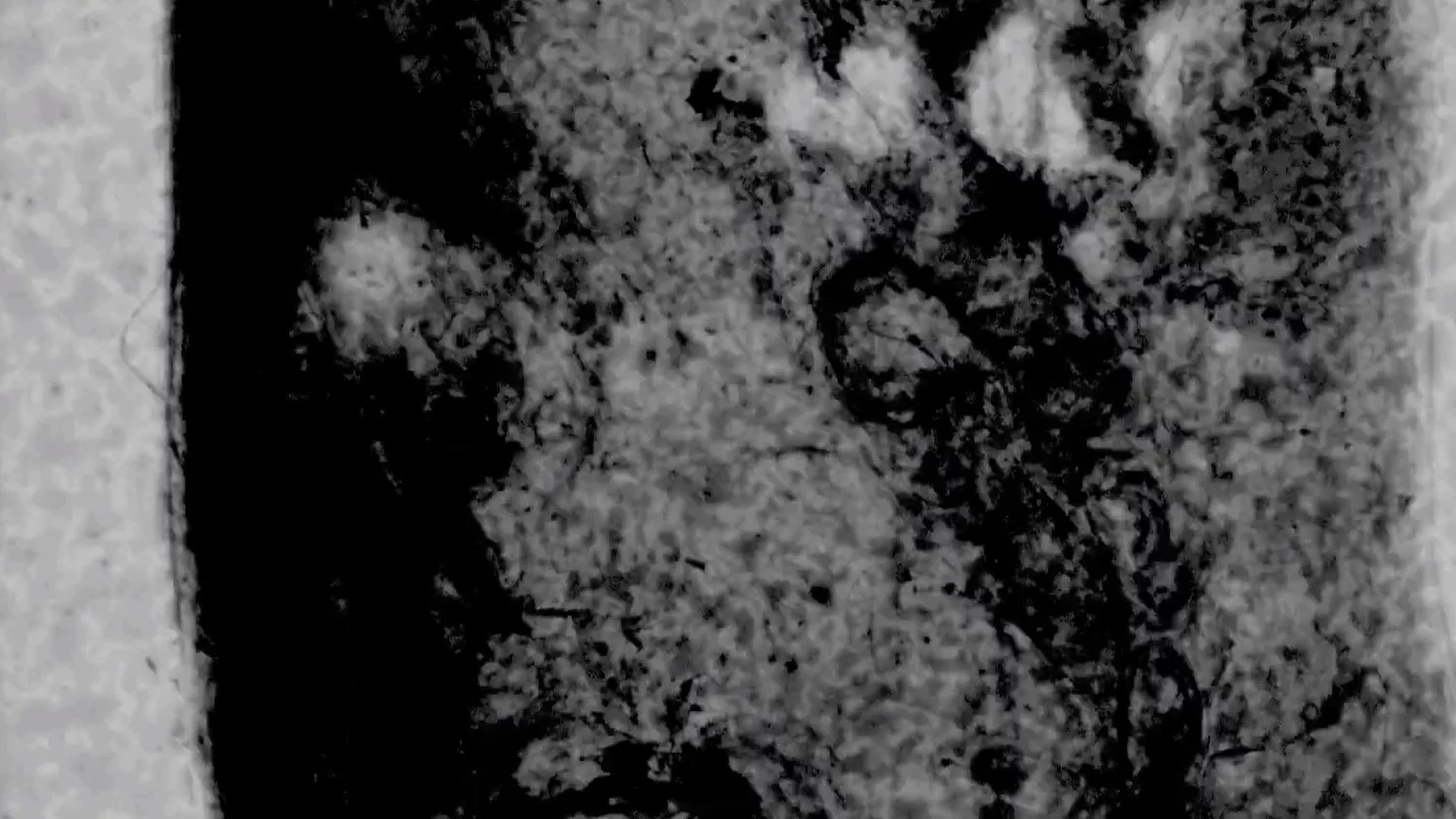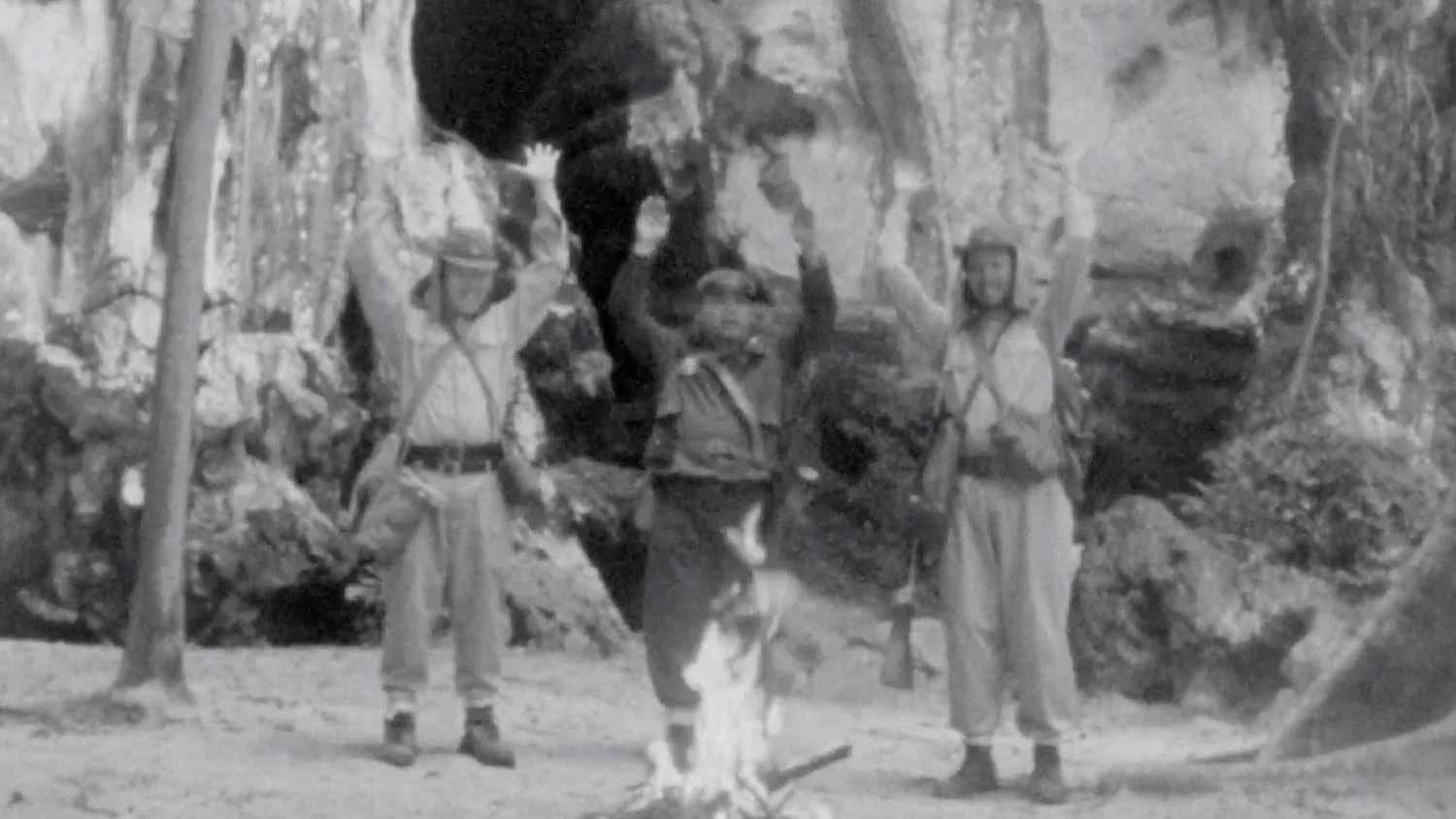Experimentations with Filmic Reality
By Lee Sze Wei

Birth of Golden Snail, dir. Chulayarnnon Siriphol, 2018: Film scratches and blotches flickering into presence.
Representations of reality on film can be seemingly realistic, or highly artificial and subjective, provoking differing levels of audience engagement with the images on-screen from the reductive to the metaphysical. Birth of Golden Snail and Stay Awake, Be Ready are inherently preoccupied with experimentation with the filmic form to depict reality in unconventional ways. Both films avoid the simple denotative meaning that moving images present but create evocative realities that immerses the audience into its richly textured world.
Birth of Golden Snail’s avant-garde filmmaking—a combination of experimental and early silent cinema techniques—makes its materiality known. The surreal film is concerned with its own mortality in using a dying film practice from before the advent of sound. Peering past Krabi’s image as a destination festered with tourists, the film’s adoption of archaic forms of storytelling interrogates the province’s forgotten past. On the contrary, through the highly choreographed execution of an unbroken 14-minute long single-take, Stay Awake, Be Ready’s construction of a seamless reality seeks to transcend conventional cinema to the hyperreal, where reality and fiction become increasingly difficult to differentiate. This serves to make us reflect on our relationship with the illusory nature of cinema and its unstable reality.

Stay Awake holds off until the very end to provoke a physiological response from its audience, making us confront the violence of its subject matter. While we recoil, there is also an underlying sense of satisfaction — finally, we get a real taste of the questions the film dances around.
While Stay Awake’s technique of presenting the grotesque has an incredible impact on the audience via a sense of shock, other films in the programme establish that this kind of optical assault does not need to involve the withholding of visual information.
Chulayarnnon Siriphol’s Birth of Golden Snail is a silent film, focusing our attention entirely on the visual. This feels like it might not be for the better during an extended sequence featuring the young female character having a sexual dream that involves snails.
Birth of Golden Snail, dir. Chulayarnnon Siriphol, 2018: Early humans discovering fire.
Shot on 16-millimetre film, the evolution of early cinema can be seen in Birth of Golden Snail’s opening transition from the experimental to the style of early silent films. Threading the lines between historical fact and folklore, the silent film directed by Chulayarnnon Siriphol depicts the history of the Khao KhaNab Nam cave in Krabi from the early humans living on the island to Japanese soldiers occupying the land during World War Two. From the formless chaotic scratches and blotches of film flickering into presence to the black and white shots of beaches, animals, and the early humans’ discovery of fire, the film through its elliptical editing provides us with an almost comical depiction of the pseudo-creation myth of the island and its three inhabitants.
The film’s lack of sound relies on intertitles (just like films from the silent era) to communicate its characters’ speech through texts on-screen. The temporal reality of the film is constantly being played with, with its constant ellipsis in storytelling. For example, the match cut of the three early humans raising their hands in celebration after the discovery of fire to the three same humans in Japanese military uniform shouting “Bansai!” shows a disconcerting jump in time to the Japanese occupation of Thailand. The elliptical montage compresses time providing snapshots of historical events but its editing technique is also highly manipulative.

Birth of Golden Snail, dir. Chulayarnnon Siriphol, 2018: Japanese soldiers exclaiming “Bansai!”.
Film as a medium eventually decays, underlining the mutability of the image that is subjected to time and the natural environment. This mutability reflects the film’s depiction of a highly subjective recount of the nation’s history coupled with the folklore of the golden snail. History and folklore seem to intertwine during the end of the film when a captured female Thai local gives birth to a golden snail. The three Japanese soldiers, after encountering the shell of the snail, flee the island on their boat. The soldiers encounter the snail, now golden in colour on another part of the island, and are taken aback, afraid, when a young boy with spectacles emerges from the shell.

Birth of Golden Snail, dir. Chulayarnnon Siriphol, 2018: Japanese soldiers retreating from the Golden Snail.
What does it mean? I am not entirely sure, but I saw it as a triumph over the Japanese soldiers. The surrealness of the film’s ending seems to circumvent the bleak narrative of the Japanese occupation with the hope and narrative power that comes from staging the folklore.

Stay Awake, Be Ready, dir. Pham Thien An, 2019: Street performer breathing fire.
Through the use of open film form, Stay Awake, Be Ready directed by Pham Thien An, immerses us into one particular night in Saigon on a busy street populated by street vendors hawking their goods and services to the locals feasting outside of shophouses. The camera’s frame is like a window, peering into the events happening on-screen as if it were real life. The supposedly omniscient camera captures it all in a wide shot, positioning us in a comfortable position to adopt a passive gaze as we listen in on how the triviality of human life is contrasted with the philosophical musings of characters heard off-screen. “Human faith swells up big real quick when they’re sick or on their last breath,” says one of them. And moments later, a motorcycle speeds past the frame and a loud crash is heard off-screen. The open film form approach makes us aware of our limited objectivity of what we see on-screen when situations happen just right outside of the frame, alluding to other narratives and a larger world beyond.

Stay Awake, Be Ready, dir. Pham Thien An, 2019: Classical music drowning out street noise.
However, what is concealed from us is the meticulously choreographed dance of characters weaving in and out the frame, background extras being barked at to recreate the same intensity of a real food street, and the vehicles’ pre-planned routes, all executed impeccably with the sole purpose of giving us a sense of heightened realism. The film is aware of its own artifice and it jolts us out of that perceived realism through its sudden use of non-diegetic music midway through the film. The sudden absence of noise from the traffic and the chatter of locals is replaced by a piece of classical music when the man on-screen puts on his earphones. Its mode of reality shifts from diegetic to non-diegetic (and back) whenever he puts on or takes off his earphones. When he is interrupted by a beer promoter or when his friends rejoin him after checking out the vehicular accident, the audience toggles between the music and the dialogue happening on-screen. The use of classical music is also highly suspect as it is anachronistic to the time and culture of what is being depicted in contemporary Vietnam. This forces us to reconsider what we have watched so far, our limited perspective and objectivity in watching the film.

Stay Awake, Be Ready, dir. Pham Thien An, 2019: The camera tracks in, focusing on the injured foot.
The camera at this point continues to push in ever closer into their conversation as the rest of the film plays out. It finally rests on a bloodied foot on a table after one of the friend trips while chasing a boy who stole his money (the chase happens off-screen). The camera’s persistent and narrowing gaze eventually focuses on the bloodied foot on the table filled with food. The film’s initial objectivity turns out to be a conceit in forcing us to ponder our own mortality as we are confronted with the triviality of the man’s injury. The onset of rain eventually forces the characters to run for shelter, leaving the camera to observe the uneaten food and drinks on the table. By the film’s end, we are made to feel thoroughly insignificant of our place in the universe while also being highly aware of its construct.

Stay Awake, Be Ready, dir. Pham Thien An, 2019: Rain patters on uneaten food.
As Krabi becomes a province rife with tourism, with its beaches and islands being increasingly populated by tourists, there is a crucial need to remember its murky past. Birth of Golden Snail’s insistence of using old forms of cinematic techniques is concerned with its own preservation of film form. Its mutability allows for the interplay and interrogation between the nation’s history and folklore, ultimately creating an interpretative reality. Stay Awake, Be Ready’s immaculate recreation of the everyday draws us into the film’s world, initially positioning us as omniscient observers only to make us question our limited grasp of the shifting modes of realities presented on-screen.
– Lee Sze Wei